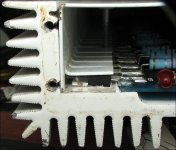Hello,
I have a PPI pro mos 450 that a friend bought used then sent to me to check.
I connected the amp, and checked all four channels - seemed fine. About 30 seconds after playing, the sound cut out, and the power led started pulsing.
I can connect ground and +12V without any apparent issues, but when I connect the remote to +12V the amp just pulses with the power led flashing.
I can't see any obvious signs of damage, short circuits in power supply devices, etc.
Any ideas are appreciated, thank you.
I have a PPI pro mos 450 that a friend bought used then sent to me to check.
I connected the amp, and checked all four channels - seemed fine. About 30 seconds after playing, the sound cut out, and the power led started pulsing.
I can connect ground and +12V without any apparent issues, but when I connect the remote to +12V the amp just pulses with the power led flashing.
I can't see any obvious signs of damage, short circuits in power supply devices, etc.
Any ideas are appreciated, thank you.
There is a bank of 5 2N6487 with base to emitter impedance reading very low, 0.2 or 0.5 Ohms. Not seeing this in the other banks of these, typically minimum of about 47 Ohms elsewhere.
Find the lowest one and remove it from the circuit. After that, do the rest read like the others?
I wound up having to remove 2 of the 5, the remaining 3 now read base to emitter resistance 47 Ohms, which is similar to corresponding measurements on the other side of the amp.
Out of circuit, base to emitter is reading 0.5 Ohms on both removed devices.
Out of circuit, base to emitter is reading 0.5 Ohms on both removed devices.
No, I know that acts like a clamp.
But, interesting story, when he received the amp, one screw was missing. That was replaced first, but maybe it caused the problem previously.
But, interesting story, when he received the amp, one screw was missing. That was replaced first, but maybe it caused the problem previously.
How much matching would you recommend for the replacements? Obviously, at least that bank of 5 should be date-code matched, should I replace the complimentary 5 2N6490 on that channel too at least?
You'll have to replace all 5 transistors in that group. I'd suggest the other 5 in that channel as well. Each group of 5 needs to have matched date codes.
Carefully check the emitter resistors as well.
Carefully check the emitter resistors as well.
Hello,
I carefully checked emitter resistors, and replaced all 10 outputs in the channel in which the bad outputs were found.
I reassembled the amp for a bench test.
The same symptom is occurring - when remoting the amp on, the power led just pulses (and my lamp dims like current is being drawn.)
I carefully checked emitter resistors, and replaced all 10 outputs in the channel in which the bad outputs were found.
I reassembled the amp for a bench test.
The same symptom is occurring - when remoting the amp on, the power led just pulses (and my lamp dims like current is being drawn.)
Now I've found at least one bad output in a group on the other side of the amp.
I don't remember seeing these last time, I guess I just missed them. Is it possible to blow outputs without even connecting speakers?
I suppose I should just lift those out a see if it powers up.
I don't remember seeing these last time, I guess I just missed them. Is it possible to blow outputs without even connecting speakers?
I suppose I should just lift those out a see if it powers up.
OK I lifted the lowest base-emitter resistance device, rest of group read OK.
Did power-up test and it appears to power up normally now.
Did power-up test and it appears to power up normally now.
Was it another 6487/6490?
It's possible to have virtually any component fail without a load. If it's another output transistor, they could be failing due to age.
It's possible to have virtually any component fail without a load. If it's another output transistor, they could be failing due to age.
Yes, and just one in the corresponding channel on the other side of the amp.
This one is a 90, before it was and 87.
The channel I replace still reads OK after letting the amp stay on idle for a few minutes.
This one is a 90, before it was and 87.
The channel I replace still reads OK after letting the amp stay on idle for a few minutes.
The outputs can overheat at idle if not clamped down. There should be no bias current (and no heating) but the biasing can drift.
You should make absolutely sure that the transistors lay perfectly flat on the heatsink. If not perfectly flat, the cover may not push them flat.The edge of the transistor can dig into the insulator and leave the transistor off of the sink (attached).
Attachments
- Home
- General Interest
- Car Audio
- PPI pro mos 450 pulses when powering on
